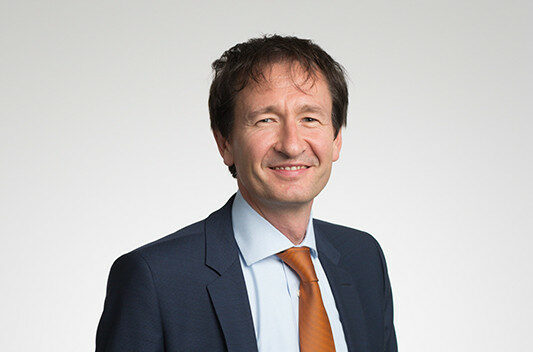The European Investment Fund has carved a distinct and tough line as a funder and driver of impact investment best practices. For EIF’s Deputy Director of Equity Investments Uli Grabenwarter that is just part of the challenge of backing social enterprises whose value is in creating true impact.

CV
- Various positions including Head of Strategic Development and Deputy Director Equity Investments EIF 2012-present. Currently oversees EIF’s venture capital, impact investing, and technology transfer activities
- Spearheaded EIF’s entry into the equity space and led development of the Social Impact Accelerator (SIA), the first pan-European social impact investing ‘fund of funds’
- Developed a novel ‘gamma model’ for assessing asset manager performance (impact/financial)
- Research on impact investing with IESE University of Navarra and the Family Office Circle Foundation analysing best practices for impact investing in the private equity and VC space, 2010-2012
- Head of Equity Fund Investments at the European Investment Fund 2000-2010
- Joined the European Investment Bank as Finance Officer in 1995
- Master’s degree in Business and Finance of the University of Graz 1987-1992
It was around 2010 when Grabenwarter started noting early signs of where a nascent market for impact investing was heading. He anticipated a great awakening and, with that, new demands on financial markets and the machinery needed to run this quirky asset class.
He understood that a fresh take on impact metrics would be needed to help the segment grow.
There were a few tools and would-be standards to compare different approaches, often tied to the UN’s Sustainable Development Goals, matching them to this or that key performance indicator, benefit case, etc. But he wasn’t satisfied that it would make measuring and reporting more meaningful in the end, especially to hesitant or unconvinced investors.
Man with a plan
He decided to do something about it, taking a 20-month sabbatical from the European Investment Fund to study these ‘complexities’. He interviewed many of the largest family offices and other leading figures in the space to assess the coexistence between impact and financial return in investment strategies.
He returned to the EIF in 2012 with a plan, and a blueprint to ramp up impact investing activities there.
That blueprint was first mapped out in a joint publication with Heinrich Liechtenstein, called In search of gamma, an unconventional perspective in impact investing, which navigates the tricky risk-return-impact trade-offs and a lot of what he shares in the course of a lengthy interview with Impact Investor.
That seminal paper painstakingly sets the scene and introduces a ‘gamma model’ for handling impact metrics in a sensible and transparent way, avoiding what he calls the “aggregation of impact parameters that become meaningless through simplification and standardisation.”
Capturing the essence
In it, Grabenwarter firmly advocates against over-standardised approaches aimed at comparing portfolios because they become so “dissociated from the original agenda that the social enterprise pursues.”
This clearly informs the EIF’s approach to metrics, giving fund managers and funded entrepreneurs as much flexibility as possible to define indicators that really capture the essence of their activity.
This, he says, leads to better-matched indicators to the business model and true theory of change being pursued. More importantly, the indicators being reported make better sense because they are “lived by the social enterprise,” not tweaked or extracted for the sake of reporting.
To explore this idea and how the EIF emerged as a pioneer in the impact investing space, read extracts of the full interview below, and the related story in this edition of Impact Investor, ‘A closer look at impact investing’s quiet achiever’.
Q&A
Impact Investor: What do you make of the signs that impact investing is mainstreaming, or is that impact washing?
Uli Grabenwarter: “Indeed, it seems to be the most sexy topic discussed in financial markets right now because everybody wants to be associated with it. For EIF and probably the entire EIB Group, impact investing is not an asset class.
“It is an approach we take to investing, which means we tie non-financial objectives to the type of activity that we apply to specific counterparts, projects and enterprises. If you look at it this way, as an investment approach rather than an asset class, it can be applied across the board to many investment or financial activities.
“That’s how we go about it at EIF. We do have explicit instruments, projects and products, but we also apply an impact- and policy-focused approach across our entire investment spectrum.”
Given that fast trajectory, do you think all investment will be impact-oriented in the future?
“In a way, it is already the case today because, let’s be honest, you can only create a successful business if your business model makes a difference to somebody.
“The real question is, what difference do you make? And what type of impact appeals to the biggest possible community of stakeholders?
“We are facing many societal and environmental issues today and they are more and more interlinked, because environmental dimensions can hardly be dissociated from their social impact. So we are on a pathway – not at the beginning but in the middle – where responsiveness to societal needs has to become a major value driver and an unavoidable element in the decision process of any investor that looks at sustainable returns.”
Looking at the EU EaSI Guarantee Instrument, do you see yourselves as something of a ‘risk release valve’ for more timid players, whether family offices, private or semi-professional investors?
“If you look at the impact investment space and diverse EIF instruments, including the EaSI and associated capital relief, some are indeed intended to modify the risk-return profile and give comfort to certain investor communities.
“Our broader, long-term objective, however, is to demonstrate that market segments are sustainable in themselves, and can be taken on by the financial community as an ‘at par’ investment type.
“The most pronounced approach to that is obviously the equity space, because it takes the first line of risk in the balance sheet of a company.
“And what we have been showing through our actions is that social enterprises and their like are not a species that needs to be specifically protected because they are ‘not sustainable on their own’; rather to give them the opportunity to demonstrate the value they can generate financially but also for society. That’s the role we’re playing.”
On that note, can you explain the SIA you developed and the impact criteria EIF now applies thanks to that?
“The SIA is a ‘fund of fund’ that pursues investment strategies targeted at companies creating explicit, tangible and intentional social impacts through their business models. The operational setup is quite vanilla. We invest in funds, they invest in companies, etc.
“But the approach we introduced in 2013 for assessing asset and fund manager performance and remuneration was (and still is) quite unique because it requires them to articulate an impact objective/agenda at the point of investment. We basically told the fund managers, ‘Put your money where your mouth is!’ Prove that your impact investment strategy creates financial returns/benefits based on an impact focus.
“That was the idea behind this linkage summarised in the ‘gamma model’ for fund-performance, the outcome of the research I carried out. It ties impact and financial return for the fund manager, to demonstrate that the financial return they’re generating/reporting to us is not just using impact as a fake wrapping, something they would have done anyway, but rather something they intentionally and consciously meant to do through the investment.
“With that approach, we try to support companies making a real difference and creating true impact rather than reporting ex-post some kind of impact that may coincidentally have happened.
“In practice, we ask them to define between three and five KPIs linked to their agenda at the level of a portfolio company, and to define objectives with respect to those indicators over the holding period of the investment. We are extremely flexible and tolerant as to what type of indicators they define.
“I found during my investigation, which led to the EIF method we use today, that if you take standardised indicators out of the context in which they’re produced, they’re not comparable anyway, even if you go after the same activity. If the indicators are not materialised in the same context, because of that fundamental difference they will not be comparable.”
In fact, you’ve been vocal about the need for greater flexibility in KPIs, or at least less homogeneity in impact standards.
“Absolutely, there is a long history of impact investing trying to make these indicators more comparable and standardised, leading to convergence of things like CO2 footprint and so on, which I find only obstructs the process.
“In the end, the reported indicator gives you zero information value because it is so dissociated from the social enterprise’s original agenda. So our approach is to give fund managers and the funded entrepreneurs as much flexibility as possible to define indicators that reflect what their activity is about.
“There are two benefits. We get indicators that are really meaningful to the business model because they demonstrate the true theory of change being pursued. More importantly ,the indicators make sense and ideally can be applied by the social enterprise in steering its business.
“That means reporting on indicators is more accurate and more ambitious than if this was just an obligatory account from a reporting tool done for remote investors, three layers up the funding chain, where it doesn’t matter whether it makes a difference or not.”
The general impression is you’re putting pressure on the whole ecosystem to up its game, and that the bar is deliberately very high when it comes to EIF-backed funds. Is that right?
“What is high and what is low is always a question of perspective. If you are above something, the bar below you doesn’t seem very ambitious. If you’re not there, then it does.
“The approach we’ve taken in the impact investment space is not so much a question of being very demanding or ambitious. We want people to ‘walk the talk’. If they say they are an impact investment fund, demonstrating they’re creating value by focusing on impact shouldn’t be that difficult.
“In the early years when we introduced this approach it was an easy tool to distinguish between genuine ‘impact-focused funds’ aimed at positive and intentional contributions to a specific societal issue, and ‘responsible-investment funds’ directed to avoid harm to society or not creating negative environmental impacts.
“The demand to tie your financial performance to the impact you’ve achieved may seem like a high bar, but I don’t think it’s an unfair bar.”





